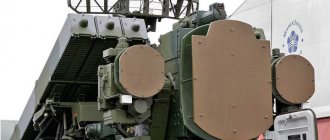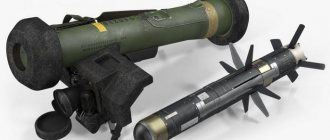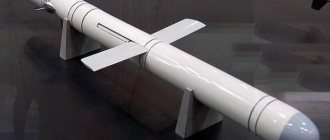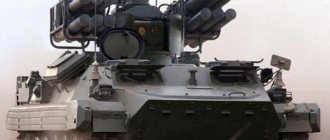"Moskit" (SS-N-22, Sunburn, ASM-MSS), anti-ship missile system with 3M-80 cruise missile
"Moskit" (SS-N-22, Sunburn, ASM-MSS), anti-ship missile system with 3M-80 cruise missile
Anti-ship cruise missile to destroy surface targets
History of creation
The 3M-80 “Moskit” anti-ship cruise missile (ASCM), as the main element of the anti-ship missile system (ASCM) of the same name, was developed by OJSC “GosMKB “Raduga” named after. AND I. Bereznyak" (Dubna, general designer I.S. Seleznev, work began in 1973) in cooperation with other enterprises. The main elements of the rocket have been developed: on-board and ship control systems - SNPO "Altair" (Moscow, general designer S.A. Klimov), ramjet propulsion engine of the rocket - OKB-670 (Moscow, chief designer M.M. Bondaryuk) and small design bureau "Soyuz" (Turaev, chief designer V.G. Stepanov), starting engine - KB-2 of plant No. 81 of the Ministry of Aviation Industry (Moscow, chief designer I.I. Kartukov). The launcher of the complex was developed at the Mechanical Engineering Design Bureau (Moscow, chief designer N.K. Tsikunov).
The anti-ship missile system with the Moskit 3M-80 missile was originally created to replace the P-15 cruise missiles and was planned for installation on destroyers, missile boats and ekranoplanes.
Before the Moskit anti-ship missile system was put into service, it underwent a large amount of testing, which began in June 1978 at the Peschannaya Balka test site with two successful throw-out launches of a mock-up rocket with a starting engine. After the flight design tests of the Moskit complex, its state tests began, which lasted until the end of 1982. They ended on November 28, 1982 with salvo firing of two missiles from one launcher from the destroyer Project 956 “Desperate” in the Barents Sea in the Northern Fleet. At a range of 27 km at a ship speed of 20 knots, the target was hit by both missiles. During these tests, out of 15 launches, 8 were considered successful, 5 were partially successful, and 2 were unsuccessful. From 1983 to 1988. The Moskit anti-ship missile system was tested to improve the tactical and technical characteristics of the ZM-80 missile (a flight range of 125 km was achieved), as well as to use it from the Lun pr.963 ekranoplane.
The ZM-80 rocket and its modifications were serially produced by Progress Production Association (now JSC Arsenyevskaya Aviation named after N.I. Sazykin, Arsenyev, Primorsky Territory).
The complex was repeatedly demonstrated at air shows in Chile, Abu Dhabi (UAE) and in Zhukovsky (MAKS) near Moscow.
In the early 80s, the Moskit anti-ship missile system with the 3M80 missile was adopted by the Sovremenny class destroyers, Project 956, and in 1984 - with the 3M-80E missile in two KT-190 quad launchers. The aviation version of the Moskit anti-ship missile system was put into service in the period 1992-1994.
Purpose
The Moskit anti-ship missile system with a 3M-80 type cruise missile is designed to destroy surface ships and transports from naval strike groups, landing formations, convoys and single ships (displacement, hydrofoil, air cushion) with a displacement of up to 20,000 tons at a speed speed up to 100 knots in conditions of enemy fire and electronic countermeasures in difficult weather and climatic conditions at ambient temperatures from –25 to +50 degrees. C, sea state up to 6 (up to 5 for small targets) and wind speed from any direction at sea level up to 20 m/s. Resistant to nuclear explosions.
The air-to-ship version of the 3M-80 anti-ship missile can be used by carrier-based aircraft of the Su-33 (Su-27K) type and is designed to destroy enemy ships.
Compound
The Moskit anti-ship missile system includes: an anti-ship, supersonic, low-altitude, homing cruise missile of the ZM-80 type, a 3Ts-80 ship control system, a non-homing launcher KT-152M, a complex of ground-based equipment KNO 3F80.
Peculiarities
The supersonic homing anti-ship missile 3M-80 “Moskit” belongs to the class of light anti-ship missiles and was created according to a normal aerodynamic design. The rocket fuselage is a body of rotation with an ogival shape of the nose and an X-shaped arrangement of folding wings and tail surfaces. The body has four side air intakes with air ducts; the front fairing has a radio-transparent spinner. Titanium, steel and fiberglass were used in the manufacture of the fuselage.
The missile is equipped with a combined (3D83 sustainer ramjet engine with a built-in starting powder accelerator) propulsion system. The accelerator is placed in the nozzle of the main engine, 3-4 seconds after launch it burns out and is pushed out of the nozzle by the incoming air flow.
Targeting is carried out by a combined (inertial navigation system with an active-passive radar homing head) control system, which ensures a high probability of hitting the target in case of enemy radio countermeasures. For targets such as a group of boats and a naval strike group, it reaches 0.99, convoys and a landing force - 0.94.
The RCC flies at a speed of more than 2M along a complex trajectory - after the start it makes a “slide”, then descends and continues its flight at an altitude of about 20 m, and 9 km before the target it makes an anti-aircraft maneuver - it descends to 7 m above the wave crest and flies along “snake” trajectories. During the flight, the anti-ship missile can perform intensive anti-aircraft maneuvers with overloads of more than 10 units. The target is hit by breaking through its hull due to high kinetic energy and an explosion inside the ship. This ensures the sinking of a target up to the cruiser, and 15-17 missiles are capable of destroying a ship group. It is almost impossible to evade the Moskit anti-ship missile, since it is detected 3-4 seconds before meeting the target and, according to domestic and foreign experts, is the best anti-ship missile in the world.
Location and condition
The Moskit anti-submarine missile system with the 3M-80 anti-ship missile system was installed: on Project 956 destroyers (2 quadruple launchers of the KT-190 type), large anti-submarine ships of Project 11556 Admiral Lobov, on more than 20 Project 1241.9 missile boats. (2 twin KTM-152M launchers on each side), on an experimental small missile ship (MRK) Project 1239 on a skeg-type air cushion (2 quadruple launchers), on an experimental MRK-5 Project 1240 hydrofoil (2 twin launchers ), on the Lun ekranoplane, can be used in coastal defense units and in naval aviation - on the Su-27K (Su-33) ship-based aircraft, one missile can be located under the fuselage between the engine nacelles.
According to the Decree of the Council of Ministers of the USSR (dated January 4, 1981 No. 17-5), the complex was modernized in order to increase the firing range by improving the characteristics of the main engine. 10 test launches of the Moskit-M anti-ship missile system were carried out in the period 1987-1989. from the boat pr.1241.1. A maximum range of 153 km was achieved, and the modified anti-ship missile was designated 3M-80E.
Currently, the Moskit anti-ship missile system is permitted for export both as part of Russian missile boats Project 12421 and destroyers Project 956E, and separately for placement on customer ships.
Presentation
The Moskit complex was repeatedly demonstrated to the Russian and world public at air shows in Zhukovsky near Moscow, Chile and the United Arab Emirates. The rocket of the same name created a sensation and caused a huge resonance in society. Foreigners were shocked by the unique characteristics of this weapon and the fact that it has no analogues in the world. The 3M-80 (“Mosquito”) rocket was and remains the only one in the world that at low altitudes can reach a speed of more than two “mach” (Mach). It is impossible to evade it, just as it is impossible to shoot it down. According to NATO classification, the missile was named Sunburn, which translates as “sunburn.”
Rocket flight
After launch, the rocket makes a “slide”, rising to a considerable height. Then it drops to 10-20 meters above the wave crest. At this altitude, the rocket passes through the marching section of the path. Approaching the target, it drops even lower (up to 7 meters from the wave crest) in order to remain invisible to air defense systems. If necessary, the Moskit missile can perform anti-aircraft maneuvers with high intensity and overloads of more than 10g. At a distance of 9 km from the target, it stops maneuvers and picks up speed. Thanks to its enormous kinetic energy, the missile is capable of penetrating the hull of any ship. The explosion occurs inside the ship and brings irreparable consequences. The impact of one missile, with a good hit, can sink a cruiser, not to mention middle-class ships. 15-17 shots from the Moskit anti-ship missile are enough to destroy an entire ship group.
From the moment power is supplied to the rockets until the first one launches, about 50 seconds pass. In a state of high alert, this figure is reduced to 11 s. During salvo firing, rockets are launched at intervals of 5 seconds.
Project evaluation
The Mosquito missile is traditionally considered a fairly effective weapon, capable of hitting targets while remaining undetected by the air defense systems of ships. The latter feature is achieved through a combination of supersonic flight speed, low altitude, and active maneuvering. Standard anti-aircraft missiles with radio command or semi-active guidance, used in air defense systems, are powerless against a Mosquito attack in a naval battle. For most of its path to the target, the missile, due to its low flight altitude, hides beyond the radio horizon. And, even if it falls within the detection radius of enemy radars, it covers the remaining segment so quickly that it is almost impossible to shoot it down.
The main disadvantage of the missile in a proposed naval battle is its relatively short range. When launching the Mosquito exclusively at low altitude, the flight range will be limited to 90-120 kilometers, which is less than most modern subsonic missiles. The reason is that when flying at supersonic speed, at low altitude, the rocket encounters very high air resistance. Theoretically, the Mosquito can fly 250 kilometers, but such a range is achieved by flying at a higher altitude while passing through the marching section. In this case, the missile appears above the radio horizon and becomes visible to radars. Therefore, the combat use of the Mosquito missile at high altitude runs the risk of making it easy prey for long-range air defense systems. Another significant disadvantage, which also affects the missile’s flight range, is its large dimensions and impressive weight.
On October 24, 2014, as part of testing the American SM-6 anti-aircraft missile, the latter managed to intercept a low-flying supersonic target, which in its flight parameters is similar to the Mosquito, except for the fact that the Russian missile is capable of maneuvering when approaching the target. The interception was made beyond the radio horizon, after an external warning, using an active radar homing head. During these tests, the ability to effectively combat supersonic low-flying missiles was demonstrated for the first time. However, the fact that the characteristics of the Mosquito missile allow it to actively maneuver at enormous speed makes its destruction an extremely difficult task for the enemy.
Modernization
On January 4, 1981, the Council of Ministers adopted a resolution on the modernization of the Moskit anti-aircraft missile system in order to increase the flight range of cruise missiles. For this purpose, the main engine was improved: it was adapted for a more energy-intensive type of fuel and equipped with a new nozzle with the ability to regulate the critical section. During the tests, 10 modernized missiles, called “Moskit-M” or 3M-80E, were launched from boat 1241.1. The launch range was unstable and amounted to a maximum of 153 kilometers.
As a result of subsequent modifications, the Moskit-MVE anti-ship missile system was created, which received a modernized ZM-80MVE missile, the firing range of which increased significantly. This complex can be supplied as part of ships or independently. It can also be equipped for installation on stationary or mobile coastal positions for the defense of maritime borders.
Control system
A high probability of hitting the target is ensured thanks to a combined control system that regulates the operation of the inertial navigation system and the active-passive radar homing head. The high accuracy of the missiles is maintained even in conditions of radio countermeasures from the enemy. For targets of the “ship group” or “group of boats” type, the probability of a hit is 0.99, and for landing formations and convoys – 0.94.
Armament
In the early 2000s, the Moskit anti-ship missile systems (ASMC) with missiles of the same name began to enter service with destroyers. The ships were equipped with two quadruple KT-190 launchers. Until the end of 1993, Severnaya Verf built 17 ships of the Sovremenny type. Several more ships remained unfinished due to the collapse of the USSR and the cessation of funding. A couple of such ships (the destroyers “Vazhny” and “Thoughtful”) were sold to China along with the Moskit anti-ship missile system.
In addition to Project 956 destroyers and Project 11556 large anti-submarine ships (BODs), Mosquitoes were installed on Project 1241.1 missile boats. The first boat of this type was equipped with a pair of two-container KT-152M launchers and put into operation in 1981. Later, more than two dozen boats were built at the facilities of the Almaz Production Association, as well as the Khabarovsk and Sredne-Nevsky plants.
The Moskit missiles were also used to equip the unique small ships of Project 1239. Vessels of this type have an aluminum-magnesium hull and weigh only 1050 tons. They are equipped with a combined power plant consisting of: a pair of gas turbines with a capacity of 20 thousand liters. With. each, pairs of diesel engines with a capacity of 10 thousand hp. With. and a pair of diesel engines with a capacity of 3.3 thousand hp. With. The speed under gas turbine engines can reach 50 knots, and under diesel engines the ship sails in economical mode (about 12 knots). Such ships are armed with two quad Moskit launchers. The lead ship of this series was named Bora and entered service at the end of 1989.
In addition, the MRK-5 ships, Su-27 and Su-32FN aircraft, as well as the Lun ekranoplane are armed with Moskit missiles.
Specifications
Main parameters of the anti-ship missile:
- Firing range from a surface ship: 3M-80 - 90 km, 3M-80E - 120 km, 3M-80MVE - 140 km (along a low-altitude trajectory) and 240 km along a combined trajectory.
- Flight speed: cruising – 2.35 M, maximum – 2.8 M.
- The minimum firing range is 10 km.
- Launch altitude – up to 12 km.
- The carrier's flight speed is up to 470 m/s.
- Post-launch turn – +/- 60°.
- Length: 3M-80 and 3M-80E – 9.385 m, 3M-80MVE – 9.745 m.
- The diameter of the case at its widest point is 0.76 m.
- Wingspan: 1.3 m – folded, 2.1 m – deployed.
- Conditions of use: temperature range – from -25 to +50°С, water waves – up to 6 for large targets and up to 5 for small targets, frontal wind speed – up to 20 m/s.
- The shelf life on the carrier in combat-ready condition is 1.5 years.
- Weight: 3M-80 – 3.95 t, 3M-80E – 4150 t, 3M-80MVE – 4.45 t.
- The mass of the warhead is up to 320 kg.
Composition of the complex
The composition of the Moskit SCRC includes:
- The rocket of the same name.
- Container launcher (launcher) model KT-152M. Serves for storing missiles on board a ship, ensuring their launch or emergency release.
- Ship control system (CSU) model 2Ts-80. Serves for: checking and preparing missiles for launch, processing data received from target designation systems (up to 4 targets simultaneously), entering this data into the guidance system, distributing missiles between targets and launching (single or salvo).
- Loading device (LOD), which is designed for loading missiles into the launcher and unloading them.
- Ground equipment complex (GES) model 3F80. Designed for transporting missiles, storing them in warehouses and arsenals. And also for carrying out their routine maintenance, preparation and delivery to the ship.
Having become acquainted with the historical background, we move on to considering the design of the Mosquito missile.









